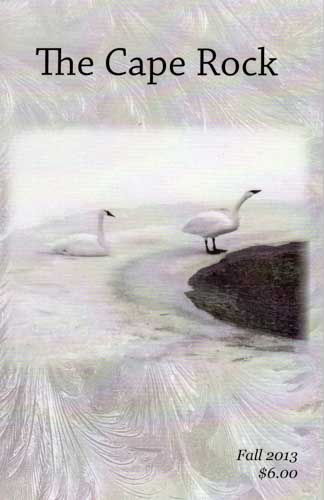The Cape Rock – 2013
This journal is a lean sixty-seven pages of poetry. No editor’s remarks, no advertisements or indices, no author bios, no other genres. The state where each author lives is identified in the table of contents and that is all. The attention in The Cape Rock is all on the work. This journal is a lean sixty-seven pages of poetry. No editor’s remarks, no advertisements or indices, no author bios, no other genres. The state where each author lives is identified in the table of contents and that is all. The attention in The Cape Rock is all on the work.
The volume begins with an interview with Debbie Benson, winner of the Vern Cowles Prize for a Trinity of Poems. Her winning poems follow. “After My Father Died” movingly visits her father’s garden after he is gone:
Grief was grisly, and filled our bellies & film-fixed eyes with
cake all fall;
But the pumpkins grew,
& left unpicked, they rotted to
sponge;
“Our Common Fever” uses “fever” to connect with the previous poem through illness, now broadened to take in the human condition. “On Dualism” then meditates on bridging the human/animal divide, which is some solace for our situation.
The pieces throughout the journal are ordered so that a connection emerges. In “On Dualism,” images of a helium balloon and a bird’s “opaque eyes, dry as cherries” somehow prepare us for the roundness and color of moons and fruit in Jody Azzouni’s “Even God is tempted by fruit,” a reverberation that continues in the next poem, Don Boes’s “Balloon,” in which a man is running through a spring landscape:
The greening
of the grid all over again. The season
is like one of those shiny unreadable
balloons snagged in the delicate branches
of a dogwood . . .
And here comes the moon again in George Looney’s “On the Politics of Graffiti & the Moon’s Dark Side” (“On the moon’s dark side, graffiti / won’t wash off. No matter / what’s scrawled in that obscure landscape”). The editors must have enjoyed arranging the poems in an associative chain. Jamie Donohoe’s “Cape-ability,” which begins with a moonless night, speaks of the necessity of negative capability to know ourselves:
you must
steep your deepest self
in nothing to know anything
but you.
The emotional tone of the selections is fairly even throughout but gradually becomes more elegiac. Another clutch of connected poems shows this. Michael Salcman’s “Why Struggle,” like Benson’s first poem, thinks about the aftermath of a death: “Fortunate in my stubbornness, I persist in leaving a track like a snail’s— / its haphazard slick may bring you back after I’m gone / exploring a final trail of words, undone but not deflected.” Laura McCoy’s “The National Museum of Ireland” displays corpses of bog men before we effortlessly move to Sandy McCord’s “Eseberg Burial,” perhaps the most memorable poem. Written with caesura breaks in each line and speaking in the voice of an ancient Scandinavian warrior contemplating the earthen burial of his ship with him in it, surrounded by grave goods; McCord evokes both early poems like “The Seafarer” and D.H. Lawrence’s “The Ship of Death.” To quote the poem in part would do it an injustice. Her next poem, “Hopperstad,” examines remnants of the Viking civilization that was superseded by Christianity:
Viking names are only marks
on gravestones in the yard.
Still, dragons perch on eaves
of the sail-shaped roof. Still,
the fjord opens out to the sea.
From here the linkages propelling us forward go explicitly into memorial and elegy. Traces of a departed friend linger in the pages of a book in Len Krisak’s “On Receiving a Book from a Poet Friend,” which is placed next to Wally Swist’s “In Memory of Jack Gilbert”:
To teach gently, then fiercely; and to discern the difference
Between the two. With you now irrevocably gone,
I envision you prospering on your own hardscrabble island
Much like Prospero . . .
V.P. Loggins’s “July 27, 1890” takes us to the field where Van Gogh committed suicide. I will stop here with the “chaining” of poems and encourage readers to seek out this volume and explore the interplay themselves.
Another recurring subject is language and writing. It appears in many guises. In Larry Starzec’s “The Flock,” we witness exactly the kind of unlooked-for moment that inspires one to write a poem:
Most things
are forgettable and forgotten.
What I remember is the flash
of birds, sparrows, dashing up
from the dried corn, maybe
a hundred all at once, like a cloud
of bees, wings fluttering frantically,
scooting up, then turning north
and just as soon veering south.
They appeared so quickly, then left,
that I was startled into slowing down.
Elizabeth Rees’s “Eating a Nectarine” initiates a clever conversation with William Carlos Williams’s “This is Just to Say.” She even admits, “I thought of cold plums / and complicity.”
The mindful arrangement of this issue should give hope to any writer looking for a close and empathetic reading. These editors do more than just publish poetry. They also honor the ongoing conversations poets have with their tradition.
[www6.semo.edu/universitypress/TheCapeRock]





